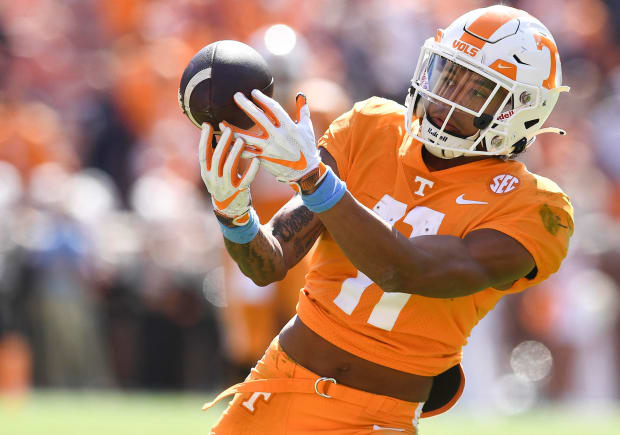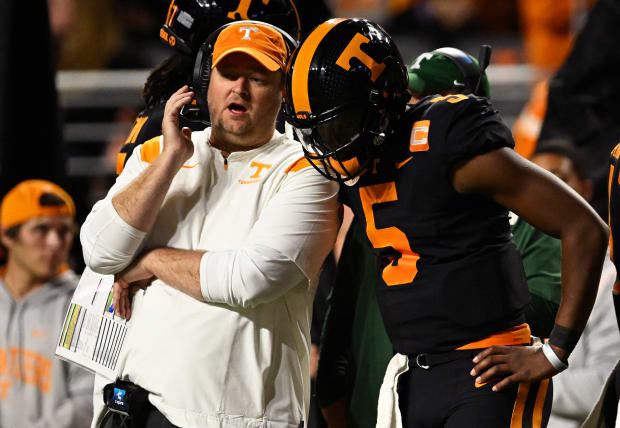Saturday’s SEC clash between Tennessee and Georgia promises to be a classic, strength-on-strength matchup with enormous stakes.
Tennessee’s first offensive snap of the 2022 season was a 23-yard touchdown pass from Hendon Hooker to Jalin Hyatt—an appetizer for the big-play buffet to come. It would only get more lavish and sumptuous from there. It has become a movable feast, a binge-worthy bacchanal, delivered with a chef’s kiss by coach Josh Heupel.
The transformation of the Volunteers into an offensive powerhouse and national championship contender has been comfort food for a downtrodden fan base and a poison pill for the first eight opponents on their schedule. After 15 years of starvation in the Southeastern Conference wilderness, Tennessee now has an appetite for destruction.
Heupel is the new vertical-game savant of college football, with a five-year trend line dating back to his time at Central Florida to back that up. His current team is his finest work: leading the nation in scoring at 49.4 points per game, in total yards per game (553), in pass efficiency (198.52), in yards per pass attempt (11.3). And, unofficially, in thrills per possession. Tennessee is a smorgasbord of sensational plays.
Dine on this: The undefeated Vols have completed at least one pass (usually more than one) of 45 yards or longer in every game. The other teams among the top 6 in the College Football Playoff rankings don’t come close—Ohio State has only four games with at least one 45-plus-yard passing play, Michigan three, and Clemson, Georgia and Alabama each have two apiece.

Carlos M. Saavedra/Sports Illustrated
Six Vols receivers have caught passes longer than 50 yards. Forget Ohio State; Tennessee is the national leader in explosive pass plays. Through eight games, the Vols have 30 passes of 30 yards or longer, seven more than the national runner-up. (One out of every six Tennessee completions is a 30-plus yarder.) And they have 19 passes of 40 yards or longer, six clear of second place, an average of 2.38 per game. Since 2010, seven FBS teams have averaged two or more 40-plus-yard pass plays per game—but none as high as Tennessee’s current average.
At a time when there is some statistical evidence that the college passing game is getting shorter, the Vols are counterprogramming. They’re digging the deep ball, stretching secondaries to the breaking point.
Even Nick Saban, the greatest defensive coach in the history of the sport, was powerless to stop the Tennessee vertical game when Alabama met the Vols on Oct. 15. Hooker threw for 385 yards and five touchdowns, all to Hyatt, who had TD catches of 60 and 78 yards in Tennessee’s 52–49 triumph. It was the most points scored against Alabama since 1907, by Sewanee, and the most allowed by a Saban team since ’96, when he was at Michigan State.
Now comes the current defensive king of college football, former Saban assistant Kirby Smart, with what should be the best chance so far to defuse the Big Orange bomb squad. His undefeated Georgia Bulldogs—No. 1 in the latest AP poll—are second nationally in scoring defense, allowing 10.5 points per game, and third in pass efficiency defense. The reigning national champions have a live shot at a repeat mostly due to their ability to choke the life out of opposing offenses.
Which brings us to Saturday between the hedges and the Game of the Year to date between Vertical Josh and Ironclad Kirby, the two leading practitioners of their respective football crafts. It is a classic, strength-on-strength matchup that carries enormous stakes, with the No. 1 team in the College Football Playoff Top 25 (Tennessee) taking on No. 3 (Georgia). The loser is not out of the CFP chase, but the winner takes a giant step toward solidifying a bid.
Heupel on the Georgia defense: “They’re long, they’re fast, they’re physical on all three levels. There’s going to be a lot of one-on-ones that we’re going to have to win. We have to be extremely physical on the perimeter.”
Smart on the Tennessee offense: “They have some traditional formations and traditional plays, but a lot of theirs is very different. It’s very unique, and they have a plan of attack based on how you’re going to play them. You’re not going to trick them. You’re not going to show them something they haven’t seen. You’ve got to do what you do better than they do, and they’re really good at what they do.”

Saul Young/News Sentinel/USA TODAY Network
What the Volunteers do, with shocking regularity, is spring their best receivers free downfield. “Sometimes it’s like, ‘Wow, no way they left them wide open like that,’” Hooker says.
There are some schematic reasons for that—no one splits their wideouts wider, for instance, truly spreading the field horizontally to the max. Hooker also gets some fairly simple read instructions that focus on one side of the field—look for open grass, and look for favorable matchups identified during the week on film. Then there is the blinding tempo at which Tennessee plays, often stressing defenses into mental errors and coverage busts. And there is the sheer talent both at the receiver position (Hyatt, Cedric Tillman and Bru McCoy) to go with Hooker’s big arm and long-ball accuracy.
All of that rests on the foundational philosophy built by Heupel: His teams are going to go deep, and it’s up to the defense to stop them.
Give him a year to get established, then look out. At UCF in 2018, with a quarterback of immense intelligence and moxie but moderate arm talent (McKenzie Milton), the Knights averaged 2.2 passes per game of 30-plus yards; one per game of 40-plus; and .39 per game of 50-plus. The next season, with a year to teach and the bigger arm of Dillon Gabriel at QB, those numbers jumped 56%, 69% and 43%, respectively (UCF led the nation in completions per game of 30 and 40 yards, even more than the vaunted LSU offense in 2019 led by Joe Burrow). And in ’20, the Knights led the nation again in 40-plus-yard pass plays at 2.1 per game.
Other than Heupel, the only coach since 2010 to have multiple teams average two or more 40-yard completions per game is Art Briles at Baylor, who did it three consecutive seasons from ’12 to ’14. The others: Kevin Sumlin at Houston in ’11 (2.07 per game); Dino Babers at Bowling Green in ’15 (two per game); and Lincoln Riley at Oklahoma in ’17 (two per game). There are some commonalities here.
Coming out of junior college, Heupel’s first season as a player at Oklahoma in 1999 was under the tutelage of offensive coordinator Mike Leach, one of the founding fathers of the Air Raid offense. Briles took some of the Air Raid concepts with him into college at Houston after being a successful high school coach, adding no-huddle tempo (and more vertical routes) to the mix. He was succeeded at Houston by Sumlin, who had previously been the co-offensive coordinator at Oklahoma while Heupel was the QB coach. Babers was a Briles assistant at Baylor. Riley began his coaching career at Texas Tech under Leach.
In sum, the Southwest was an incredible incubator of fertile offensive minds—coaches who wanted to play fast and fearlessly, spreading the field and chucking the ball deep. Heupel is the latest coaching star to emerge from that lineage. As a coordinator at Oklahoma, Utah State and Missouri, his offenses enthusiastically took deep shots. It has carried over to his work as a head coach, along with coordinator Alex Golesh (in his third season with Heupel) and quarterback coach Joey Halzle (in his 12th season with Heupel).
“Scheme is putting your players in position to be successful,” Heupel says. “What can they do individually at a really high level? Let’s put them in a position to do that. Then your players have to be able to go out and execute; that’s understanding your job, that’s offseason training, it’s understanding defenses, and it’s putting your quarterback in position to be accurate with the football.”

Eakin Howard/Getty Images
Since arriving as a transfer from Virginia Tech last year, Hooker has made huge strides as a passer. He was not the Day 1 starter at Tennessee—Michigan transfer Joe Milton started the first two games of 2021—but took over in September and had a very good first season. This year the 24-year-old, sixth-year collegian has taken his performance up to a Heisman Trophy candidate caliber.
“Hendon’s development since we got here is a great story,” Heupel says. “Especially this offseason, he’s become comfortable and confident in his own skin. From the first day we got here to who he is now, he’s fundamentally changed who he is.
“His platform in the pocket, the ability to subtly move in the pocket, find the soft spot, keep his eyes downfield and be in good position and deliver the football. His motion has become way more consistent, which has allowed his accuracy to improve. Then you pair that with his football IQ and understanding of what we’re doing, and what defenses are doing, is at a completely different level than when we first got here.”
Despite Hooker being very good at throwing those deep passes, Tennessee’s staff is impressed with his restraint when needed. That’s helped keep his interception total to a microscopic level—one in his last 11 games going back to last season.
“As you start to have success in this style of offense, a lot of guys start to get greedy,” Halzle says. “You’re not seeing that from him at all. You’re seeing him check down to the tight ends and the backs, you’re seeing him get the comeback [routes]. Sometimes it would be easy to just drop back and try to throw it as far as you can to Jalin, but he’s not just launching the ball. When he’s taking his shots downfield, it’s calculated, it makes sense to him, and that’s why you’re seeing the completion percentage he has downfield at such a high clip.”
Watch SEC football with fuboTV. Start your free trial today.
Hooker’s development and the emergence of Hyatt as the most dangerous receiver in the country has been a combustible combination. Hyatt leads the nation in touchdown receptions (20) and is the only player with 45 or more receptions to average more than 20 yards per catch (20.16)—numbers that compare well to the two best receivers to come out of college in the past five years. LSU's JaMarr Chase had 20 TD catches in 14 games and averaged 21.19 yards per reception in 2019, and Alabama's DeVonta Smith won the Heisman the next season with 23 TD catches in 13 games and 15.86 yards per reception.
Hyatt, a 6-foot, 185-pound junior, has added 10 pounds of muscle and believes he has gotten appreciably faster. “Sometimes when I go out there,” Hyatt says, “I feel weightless when I run.”

There are many other options. Tillman came into the season as Tennessee’s No. 1 receiver but missed four games with an ankle injury. Still, he was instrumental in the Vols’ overtime win over Pittsburgh, catching nine passes for 162 yards and a touchdown. McCoy, a USC transfer and former five-star recruit, has had a pair of 100-yard receiving games. The vividly nicknamed freshman Marquarius “Squirrel” White had his first 100-yard game last month.
“You’re going to have to pick one,” Hyatt says. “Who do you want to stop?”
Of course, Georgia has some defensive backs who are up for the challenge. Safety Christopher Smith is a veteran performer with five interceptions the past two seasons. Kelee Ringo, one of the stars of the national championship game last season, is a projected first-round draft pick. “I don’t think Kelee’s lacking in confidence,” Smart says. “What he has ability-wise is the tool set that most guys wish they had.”
The Bulldogs aren’t a unit that allows receivers free rein getting off the line of scrimmage or going after 50-50 balls. They will be physical from the outset with the Vols wideouts. Let’s hope those downfield plays don’t become the province of officiating judgment calls on pass interference.
The Georgia secondary against the Tennessee receivers is the matchup of the day within the national Game of the Year to date. A great offense against a great defense, two talented units led by great coaching minds. Whoever wins the deep shots may well win the game, the SEC East, and eventually a playoff bid. There is so much on the line, and it should be so much fun to watch.
More College Football Coverage: